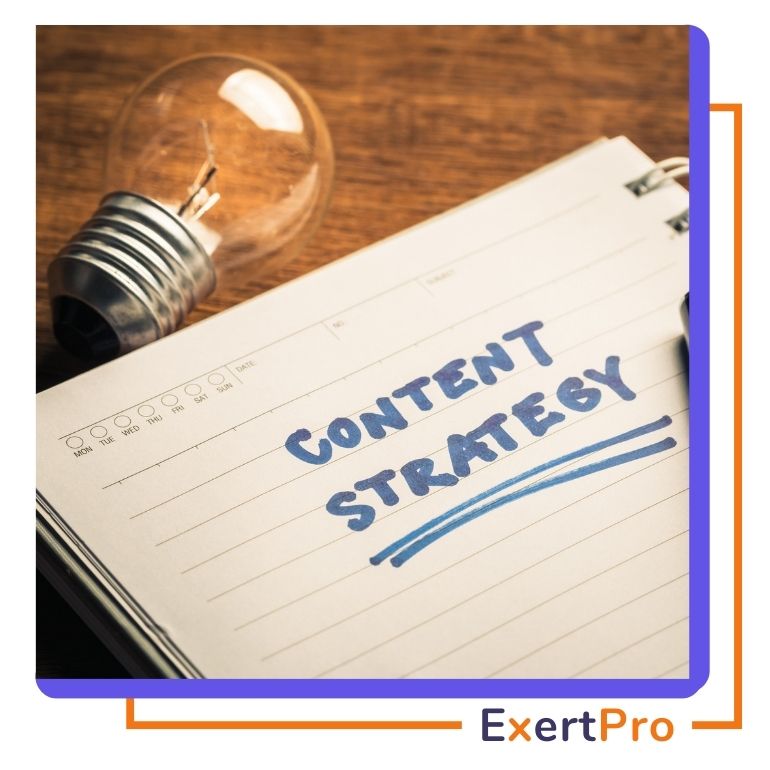Every day Google searches are happening by 8 billion. And by 2024, content marketing will experience a skyrocket, worth approximately $600 billion. Hopefully, all these numbers are enough to click on your brain that your ecommerce brand requires the most incredible content marketing strategy.
Developing a winning e-commerce content strategy is a daunting task, and it requires enormous effort. But once you successfully implement the strategy in your website, it will significantly drive sales by engaging your audience.
Content strategy development includes knowing your audience and their buying cycles and building a content team and content model. Some more are identifying content types and channel-specific content, generating content marketing campaigns, understanding SEO blogging, etc.
You will explore more detailed ways of engaging the audience and driving sales through content strategy development. So, get going into this comprehensive guide.

What Is E-commerce Content Strategy?
Ecommerce content strategy aims to maximize online sales by supporting the customers through their entire product buying process. An effective strategy throughout the customer journey integrates valuable content.
The top-class content strategy ensures that any time buyers will access the relevant information through the appropriate channel.
The ecommerce website’s content is differentiated by the value that it supplies to its customers. To improve your e-commerce content marketing strategy, follow the tips below:
- Keyword research
- Find new innovative content ideas
- Get more insights by analyzing the competitors
- Optimize the existing pages
An e-commerce website can provide product’s necessary information to its customers with a perfectly designed content strategy. Also, the e-commerce strategy enables a website to provide thought leadership.
How To Develop A Winning E-commerce Content Strategy?
Do you ever ask yourself why you must develop the most effective e-commerce content strategy? The answer is to engage your audience, draw more sales, and increase your business revenue.
A content strategy that contains the product’s valuable and essential information, headless CMS, and visuals will draw more customers than others. All these elements will force your audience to focus on your product and services. Ultimately it will improve your sales by creating customer interest.
Content is the king that drives business online. And it results in likes, shares, comments, and sales. By following the e-commerce content strategy your content can drive your client’s buying behavior.
Now let’s learn how you can develop a winning e-commerce content strategy:
1. Know Your Audience
The first point of developing the best content strategy is to understand why and how people purchase the product that you sell. Whether you sell services and products on your website or third-party platforms like Amazon, you must understand your buyer’s content requirements.
Map out which type of content they are looking for. Also, another central point to consider is how people find your business products. Customers can see your product through search engines, social media, other customer reviews, and many more.
A younger audience is more likely to be active on social media and can find your product from there. If you understand the source of your audience’s knowledge about your product, you can provide more content on that platform.
It will help your business to reach your audience more quickly. If you know your customer’s source, choice, etc., you will more likely be able to map their behavior or how they purchase products.
Create content in such a way that it will attract your customers from different sources. It can be a website, social media, blog posts, or anything. So, knowing your customer is vital to deciding which content you should produce.
2. Understand Your Target Audience’s Buying Cycles
When developing a content strategy, first, you must understand your users’ search behavior. Also, learn how to correlate your user’s behavior to your website. Learning about your customer’s buying cycle is a must.
Buying cycle helps to narrow down the approach. As a good content strategy developer, you must know that buying/sales cycle involves multiple stages. You have to go through those stages to simplify your content-creating process.
3. Build Your Content Team
Building a solid content team is a must to develop your ecommerce business content strategy. There is no lack of talented content writers around you. You need to find the best one to form a strong team.
Many professional and competent content writers at an affordable rate are willing to work with you. If you want to skip this step, there is no chance. Because the ecommerce business eventually requires a professional team.
4. Build A Content Model
After mapping out the content, your most important job is to create the content model. The model generates guidelines for creators to structure content models to fit their strategy.
First off, identify all those entities that you plan to map. The identities include products, categories, channels, campaigns, product managers, etc. After mapping out the entities, your next job is determining what you must capture for your products.
For each product, start with its name, price, description, and image. Include the keywords for writers to create content. Also, add the information that customers require to make the purchasing decision. For your content model, some more considerations are:
- What should be each content’s length? Do you require the content in a long or short version?
- Did you develop product-specific content? If your customers look at your product’s detail, will they be able to distinguish your product offering from your competitors?
- What significant points should the writers include in their content to make it more detailed?
- How do you track content reviews? Search engines first gather your product reviews and, to your potential customers, it displays the reviews. So plan accurately to manage and store those search engine ratings.
Every year a new product will emerge. Make your content model flexible so that you can handle the new product’s trends and channels. After developing a model, your next aim should be to populate the model with the best content.
Ensure your creative production team is perfectly capturing all the correct information. In a structured CMS, you can implement the content model to help your innovative team to manage your organization’s content.
5. Identify Channel-Specific Content
Identifying channel-specific content is an effective way of developing an e-commerce content strategy. First, you must know your audience’s channels to reach your product. After identifying the channel, you will quickly understand what content you should create.
For example, if your audiences are mainly from TikTok, you can generate your product-related informative and funny videos in TikTok. Likewise, if your users are from Facebook, you can generate a fantastic graphic for them.
However, some content can be effective across different platforms irrespective of channels. For example, you can create product captions and descriptions and share videos across your website and on multiple social media platforms. Using hashtags is also a prevalent strategy.
You must put your unique content investment and effort into the expected returns for each channel. Refrain from overinvesting or emphasizing any specialized content in exchange for your core content requirements.
For example, customers must get the necessary basic information to purchase your product. Otherwise, your good social media hook won’t be helpful without basic knowledge.
6. Identify The Content Types To Use
The e-commerce content strategy is more about your product and category page optimization. The best ecommerce stores increase their conversions by leveraging their social media, blogs, videos, and image power.
You can develop content based on the ideas below. It will help to target users to buy products and enhance the eCommerce website strategy. The content ideas are:
- Video content
- Product reviews and comparisons
- Buying guide, tutorial/how-to content
- Blog posts and niche-topic articles
- Coupon, discount, and sales pages
- “Round-Up” and multi-expert articles
- Product image galleries
- FAQ pages etc.
When you decide to invest in ecommerce content, you have to consider many factors. But your audience personas should always be on the list’s top. Also, focus on your customer’s funnel stage and their pain points.
We recommend you conduct demographic Research on your audience if you aren’t sure of which content format will attract your audience. You can also brainstorm and organize the content topics that will resonate with your customers.
7. Generate Content Marketing Campaign Calendar
Your content relevant to all jobs is done. You have assembled a strong team and written high-quality content and product descriptions. Now it’s time to generate your campaign calendar for your content marketing.
In the step, the game’s name is Research!
And here comes the importance of an excellent content marketing tool’s power. Behind the keywords, you have to get the data’s access.
Through the data access, you will know which one to pass on or add to your calendar. You can use the collaborative and affordable tool to create your content calendar.
8. Embrace SEO Blogging for E-Commerce
According to research statistics, 59% of purchasers do Google research before buying anything. So hopefully, you understand the fierce competition in online business. Accompanied by your ecommerce digital marketing strategy, a big step to include is SEO blogging.
Creating amazing SEO blogs is necessary to implement your ecommerce content strategy successfully. You require time, skills, knowledge, tools, and money to create a fantastic SEO blog for your website.
Good SEO blogging will significantly help your ecommerce site stand out even if you have stiff competition. Before buying your products, your customers get their answers through SEO blogging.
Creating long-form content of a minimum of 1500 – 2000 words is key to SEO blogging. For your ecommerce business, this is the biggest content pillar. So focus on it to target your product’s audience.
9. Focus On The Headless CMS
You need a winning e-commerce content strategy to manage your content materials better. The strategy will streamline how to generate, manage, and publish your e-commerce content. It also includes the tricks of once on multiple channels posting the same content.
In this case, the solution is to enter headless CMS. The headless CMS enables the vendors to store their content in one repository with effective information-presenting systems.
Through a headless CMS, compared to the traditional system, you can store content in a structured manner. The headless CMS in a central location maintains your content whether you push it to your website, a print queue, or a social media site. The headless CMS also does the following:
- It organizes crucial metadata
- Collects, distributes, and structures content with APIs
- Maps out the linked content’s relationship
The front-end developers can emphasize content once the headless CMS is in the correct place. As a result, they can simplify the new product adding and updating process. And they satisfy customers by generating more functional designs.
10. Keyword Volume
For your product content ideation, a great starting point is keyword research. But it’s just a step. There are more to develop the best content strategy. You can find your industry or product-related popular topics or keywords using tools like Ahrefs and SEMrush.
These tools help research specific product categories or items. While selecting the keywords, avoid choosing high monthly keyword volume. Instead, select the longer tail low-volume keywords that will drive high-intent users to your site.
While selecting the keywords, you must consider whether they will fit your audience’s particular interests and buying funnel stages.
11. Develop High-Quality Content
Content is king, and it can make or break your online business sales. So you must create high-ending content considering what product you are selling. Create your product relevant content.
Consider your experience of last online shopping. What did you do while you were shopping online? First, perform a search, see the results, and open or click on the top-ranking choices, right? Or you can open a product by clicking on your social media feed’s well-placed ad. So your customers also behave just like you.
To engage more audiences, you must teach your content creators to generate the best content for selling products. Work with your content creator to find out which type of content attracts your customer’s attention. Think from a buyer’s perspective.
However, in developing content, some eye-catchy factors are:
- High-Quality Picture: Capture your product’s picture so that photos will reflect your product’s overall view. Also, ensure the images have the product’s all distinguishing details with detailed thoughts.
After searching for a product, the customers zoomed in or looked at the product from a different perspective. So make sure the product image is clear and all the details are visible in the picture.
- Detailed Product Descriptions: When the search engine displays a product, it shows a few sentences that describe your product. So, you can understand that this short paragraph or product description is crucial.
These few sentences are your product-related questions that the image and title won’t reflect. However, your site can have a detailed product page where the users will find more detailed and longer product descriptions.
The search results reveal little but essential information. And the product page serves to reinforce this.
- Engaging Titles: You must capture your audience’s attention at first look. Or you have to build your product’s first impression to the users through its captivating title.
Place an eye-catchy title in the keywords. It helps your product content to appear in the search results. And people also understand the item. The image, price, and title combination greatly help narrow the options.
Whether you sell products or consulting services, your sites require the following:
- Title
- Elevator pitch
- Tagline
- Product or service’s detailed description
You should have each content component’s version for each product you are selling. You must use these content components to maintain your potential buyer’s interest throughout your online properties.
12. Continually Update Content + Measure Results.
In a few days’ gaps, regularly check out your Google Analytics and find your most popular posts.
Why?
You have to keep your popular posts updated and fresh. You can optimize your posts for sale if it starts getting traffic. And once sales come from your post, you must update it regularly to keep it going. Here also, the SEO research tool and your keywords are crucial.
Plug your high-ranking posts into these tools to get essential data. Afterward, for your ranked keywords, you will get deep insights. And you can refine, tweak or optimize the ranking keywords in the search engine.
Different problems can occur with your existing content, such as links breaking, buttons going dead, or changing your business products. You will get all these insights by using the tools. So, update your old content to keep your blogs fresh, relevant, and high quality.
How To Execute Content Strategy?
So you have developed your award-winning content strategy. Now it’s time to set your content strategy in action. Before executing it, you must decide whether to take the professional’s help or enforce the strategy independently.
Creating engaging and compelling content is time-consuming. You may need help managing all these aspects if your marketing team is small. To keep your content strategy execution train rolling, you require sufficient time and energy.
So to execute your content strategy, you may require helping hands. And they may come in different forms:
- SEO content planning specialized agencies
- Full-service content agencies
- Freelancers who create full-fledged content and videos etc.
However, you can also use AI tools to kick-start your content creation. But using AI-created content on your website without human touch is not recommended.
The main line is to avoid biting off more than you chew. To implement content strategy, develop a strong content-based team. Ensure the team is capable enough to accomplish all your strategies reasonably.
Frequently Asked Questions
How Do You Create an Effective Content Strategy For Ecommerce?
Start by identifying and knowing your audience, embrace SEO blogging, and build your content team. Some more are creating high-quality content and product descriptions for SEO, etc.
What Is the Content Strategy for an Ecommerce Store?
Ecommerce store content strategy is supporting your customers to maximize your online sales. It includes the process of helping buyers in their product-buying journey.
What Are The 3 Most Important Elements of Content Strategy?
Content strategy’s three essential elements are user experience, brand focus, and content distribution.
Final Thought
The proper execution of your e-commerce content strategy with high-quality content and well-researched keywords is crucial to your business success. You can engage your audience and sell more products online by developing the best content strategy.
Content strategy is an effective way of turning your potential customers into a lead and actual buyers. And you can build an effective strategy by following our tips mentioned above. Comment to let us know your thoughts. ASAP we will reply to you!





